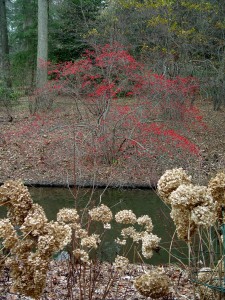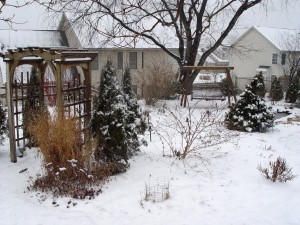Winter Wonderlandscape…or Not
February 23rd, 2006
Finally… a winter in which we could actually get out into the yard.
But was there anything to see?
“Anyone can do a nice garden in June,” says David Culp, a Longwood Gardens instructor and contributing editor to Horticulture magazine. “It’s a lot harder in winter.”
This winter has been a good lesson in why NOT to put all of your eggs into the flower basket.
Massive flowering might be wall-to-wall spectacular during the growing season, but then you’ve got a black hole from November through March when frost kills the annual flowers and knocks back the perennials to their roots.
Culp, who gardens in Chester County, is among a trend-setting group that thinks we should pay more attention to the landscape in winter.

Berried shrubs and browned-out hydrangea blooms add interest to this winter garden.
“One reason I live in the mid-Atlantic is that I like the change of seasons,” he says. “I enjoy all four seasons, and I want to celebrate each of them.”
Gordon Hayward, an acclaimed landscape designer and prolific garden-book author, is another winter-garden champion who spoke on the topic at this month’s annual nursery conference at Penn State University. He said the key to a beautiful winter landscape is the “bones” of it – not the plants.
“A winter garden is all about your ability to design a good framework, a good structure,” Hayward said.
He suggests starting with the paths.
“If you get the paths wrong, the plants are not going to save you,” he said. “The paths have got to link your house to the yard.”
Hayward starts with a home’s doors and then designs paths that lead from them to places where people move about the property – i.e. the driveway, the mailbox, a shed or gazebo, around the side of the house and so on.
Paths can be floor-like, such as with bricks, flagstone or pavers, or they can be informal mulch or even grass bordered by garden beds. The point is to define where people are to walk.
Hayward prefers straight lines for his paths because they can play off of the lines of the house.
“I think America has gone curvy-crazy,” he says. “It’s almost as if straight lines have been outlawed.”
Either way, the location of the paths will help dictate where structures and ornaments should go.

Structures, accessories and other hardscaping become stars in the winter landscape.
If you’re having trouble figuring out where a gazebo or bench or get-away water garden should go, think about where it makes sense for a path to lead. Then make your gazebo, bench or water garden the destination at the end of the path.
Ornaments such as statues, sundials or all-weather pots also make good sense at the beginning of paths, the end of paths and/or spaced equidistant along a path.
“I see ornaments as magnets to draw people along a garden,” said Hayward.
The first plants Hayward places in any design – winter-oriented or not – are the evergreens, which he considers “the backbone of the winter garden.”
He decides where evergreens are going to go throughout the whole design, repeating them at regular distances or using them in clusters. He also makes sure to use evergreens to block views the homeowner doesn’t want to see at any time of the year.
“It’s important to establish the edges of a property with evergreens,” Hayward said. “So many people have woods along a border, but when the leaves drop, then they can see their neighbors.”
That doesn’t mean entire properties have to be lined with green walls… just that evergreens should go in key spots up front.
Evergreens also make a nice backdrop during the growing season for flowering shrubs and shrubs that turn color and/or develop berries in fall.
Only after the paths and evergreens are placed does Hayward begin to think about the perennials and other color plants.
Before digging the holes, Hayward also suggests considering what your gardens will look like out key windows – especially in winter.
“A winter garden really takes it cue – more than any other garden – from the windows and doors,” he said. “You might not go out a lot in winter, but you do look out a lot.”
If you’re stuck on where to place garden beds and how big or what shape to make them, Hayward suggests looking instead at the shape you make the lawn.
If you shape the lawn so that you see a nicely formed oval or circle or rectangle when you look out an upstairs window, the beds will then fall into place around it. That’s a lot better, Hayward says, than building a series of randomly placed small beds that end up looking like a “collection of amoebae.”
The bonus to this winter-planned design is that the good structure also makes the growing-season landscape look organized and well designed, too.
“If you get the framework right, the rest of the year is easy to manage,” Hayward said.
Probably the toughest hurdle, says Culp, is getting gardeners to think about what the winter landscape looks like in the first place.
Unlike summer’s garish beauty, a winter garden’s beauty is more subtle and takes a little more planning.
“You just have to work at it and think about it,” says Culp.
Do it well, and the winter landscape practically sings for you to come out.
“I enjoy being out in the garden this time of year,” Culp says. “The light is so clean and low-angled. And you don’t need bug spray either.”
EIGHT WAYS TO ADD INTEREST TO YOUR WINTER LANDSCAPE
1.) Pay attention to plant forms. Use evergreens of different shapes (pyramidal, rounded, topiary, etc.) and select at least a few leaf-dropping plants with interesting branch habits, such as a Harry Lauder’s walking stick (a dwarf, contorted filbert) or a “wedding cake dogwood” (a small tree with a layered habit).
2.) Use plants with winter berries. Examples: winterberry holly, blue holly, crabapples, viburnums, hawthorn.
3.) Use plants with colorful winter foliage or stems. Examples: golden Hinoki cypress, blue holly, blue spruce, red-twig and yellow-twig dogwoods, coralbark maple.
4.) Use plants with interesting bark. Examples: stewartia, crape myrtle, birch, ninebark, Kousa dogwood, oakleaf hydrangea.
5.) Use plants that flower late in winter. Examples: witch hazel, helleborus, winter aconite, snowdrops.
6.) Use perennials that hold their leaves or form through most of winter. Examples: liriope, coralbells, lavender, lamium, ornamental grasses, sedum.
7.) Plan for at least a few structures in the yard. Examples: arbors, pergolas, gazebos, trellises, boulders, gates.
8.) Add a scattering of ornaments that can stay outside in winter. Examples: stone or concrete pots, birdhouses, bird feeders, winter-hardy statuary, wind chimes.







